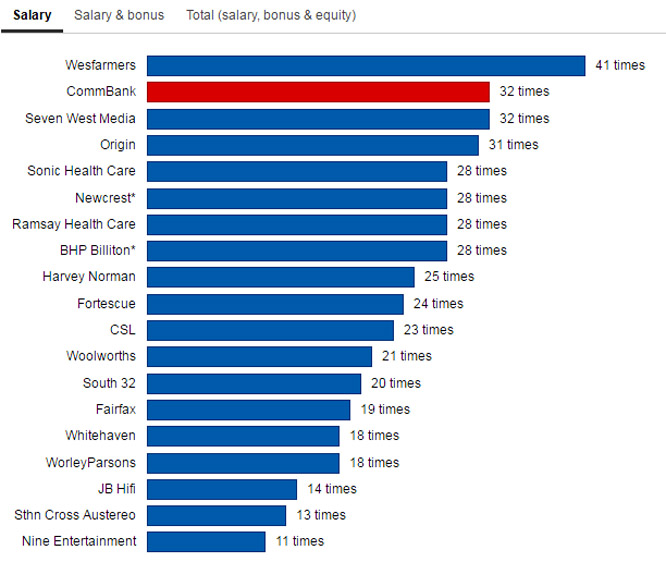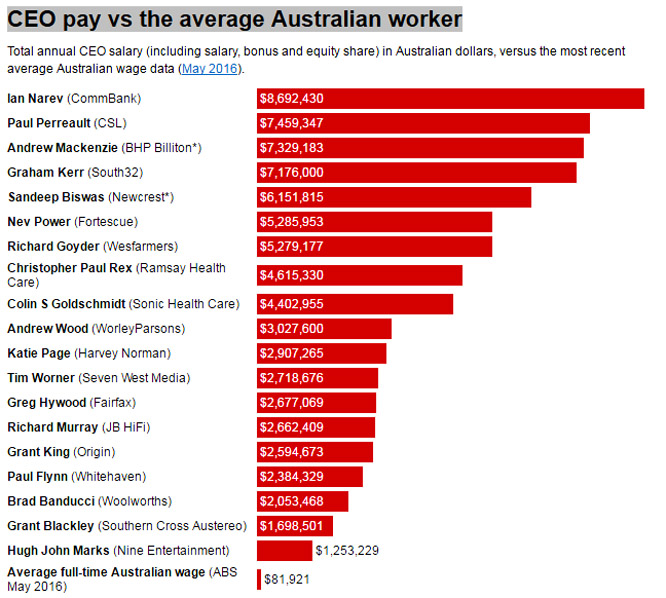Australia should compare CEO and average worker pay as the US and UK do - Julie Walker for the Conversation - 28 Sept 2016
Pay ratios are an important measure of income inequality over time and regulators should look at making them mandatory

Australia should follow the lead of the US in requiring public companies to disclose how much their chief executive makes each year directly compared with an “average” rank-and file-employee. Ballooning executive pay contributes to income inequality and the CEO pay ratio provides a measure of the pay gap between the top and bottom income levels in the economy.
US companies will be required to disclose from 1 January 2017 the ratio of pay of a chief executive’s annual total remuneration to the median annual total remuneration of all company employees.
|
SEC Adopts Rule for Pay Ratio Disclosure Rule Implements Dodd-Frank Mandate While Providing Companies with Flexibility to Calculate Pay RatioFOR
IMMEDIATE RELEASE Washington D.C., Aug. 5, 2015 — The Securities and Exchange Commission today adopted a final rule that requires a public company to disclose the ratio of the compensation of its chief executive officer (CEO) to the median compensation of its employees. The new rule, mandated by the Dodd-Frank Wall Street Reform and Consumer Protection Act, provides companies with flexibility in calculating this pay ratio, and helps inform shareholders when voting on “say on pay.” “The Commission adopted a carefully calibrated pay ratio disclosure rule that carries out a statutory mandate,” said SEC Chair Mary Jo White. “The rule provides companies with substantial flexibility in determining the pay ratio, while remaining true to the statutory requirements.” The new rule will provide shareholders with information they can use to evaluate a CEO’s compensation, and will require disclosure of the pay ratio in registration statements, proxy and information statements, and annual reports that call for executive compensation disclosure. Companies will be required to provide disclosure of their pay ratios for their first fiscal year beginning on or after Jan. 1, 2017. The rule addresses concerns about the costs of compliance by providing companies with flexibility in meeting the rule’s requirements. For example, a company will be permitted to select its methodology for identifying its median employee and that employee’s compensation, including through statistical sampling of its employee population or other reasonable methods. The rule also permits companies to make the median employee determination only once every three years and to choose a determination date within the last three months of a company’s fiscal year. In addition, the rule allows companies to exclude non-U.S. employees from countries in which data privacy laws or regulations make companies unable to comply with the rule and provides a de minimis exemption for non-U.S. employees. The rule does not apply to smaller reporting companies, emerging growth companies, foreign private issuers, MJDS filers, or registered investment companies. The rule does provide transition periods for new companies, companies engaging in business combinations or acquisitions, and companies that cease to be smaller reporting companies or emerging growth companies. The rules will be effective 60 days after publication in the Federal Register. FACT SHEET Pay Ratio Disclosure SEC Open Meeting August 5, 2015 |
UK companies are also subject to a variation of the CEO pay ratio rule, requiring
the disclosure of the boss’s
remuneration compared with employees. In
Australia companies don’t have to disclose this ratio, although companies do
disclose information about remuneration for executives.
Disclosing the ratio provides greater transparency and places some restraints on escalating remuneration.
Chief executives in the US are paid about 300 times the median employee wage, while in the UK the ratio is roughly 183:1.
The graphic below shows CEO pay compared with the average annual Australian pretax salary for a selection of large Australian companies. Comparing CEO pay against the median pay of a worker at the same company is the ideal way to compare ratios, given that companies in some sectors pay workers higher across the board. But a comparison with the average worker salary also provides insight into income inequality.
How many times the average annual salary are Australia's CEOs paid?
The average annual
full-time salary is $81,921 pre-tax, based on the most
recent ABS weekly wage data (May 2016).
While the salary
for all of the listed CEOs is already over ten times the annual wage of the
average Australian,
CEO take home pay is
highly affected by bonuses and equity allocation.
For instance, the annual pay packet for CommBank CEO, Ian Narev, goes from 32
times to 106 times the average annual wage when his bonus and equity are taken
into account.

*Converted from Australian
dollars based on May 2016 average conversion rate.
CEOs chosen from companies with largest market capitalisation on the ASX 200
across a variety of different sectors.
Companies that report only in the US or out of cycle were not included.
The Commonwealth Bank has the highest CEO pay ratio in our sample,
with Ian Narev earning more than 100
times the salary of an average worker. Even the lowest paid chief
executive in our sample earned 15 times the average Australian annual
salary. The figures for many of the corporations were impacted by the
inclusion of bonus or equity elements of pay. For example, Fortescue Metals
is the second highest ranked when salary and bonus are considered, but falls
to sixth place when equity-based remuneration is also considered.
There’s quite a debate about what actually makes up CEO pay. Some argue that US pay ratios are more like 70 to one when only cash remuneration is taken into account. Others include equity claims exercised – like stock options – and come up with a much higher ratio of something like 300 to one.

*Converted from Australian dollars based on May 2016 average
conversion rate.
CEOs chosen from companies with largest market capitalisation
on the ASX 200 across a variety of different sectors.
Companies that report only in the US or out of cycle were not
included.
Cash bonuses paid to chief executives are likewise controversial, with some suggestions that observed reductions in CEO pay levels in 2015-16 are simply a case of shifting pay into cash bonuses rather than cash salaries. Certainly the ranking of our sample firms change when cash bonuses are included, indicating that bonuses are a significant source of remuneration. A cash bonus is effectively the same as a salary if it’s very likely to be paid and so should logically form part of the pay ratio.
The CEO pay ratio is an important measure of income inequality over time and Australian regulators should consider making this information mandatory. This would greatly enhance comparability with US and UK companies.
Research evidence describes wide differences in CEO remuneration across the world, with US CEO pay described as an outlier at 23% greater than the UK and 55% greater than continental Europe, thereby contributing to income inequality in that country.
Disclosure of the ratio would allow Australian investors to understand better where a particular chief executive lies in terms of pay packet size relative to other firms of similar size and industry.
In recent years, Australian corporate boards have been subject to the two-strikes legislation under which shareholders vote on the company’s remuneration report at the annual general meeting. Any company receiving 25% or more of no votes from eligible shareholders at two consecutive meetings must put a motion to shareholders to spill the board.
The increased accountability around remuneration resulting from the two-strikes rule has provided shareholder and lobby groups with solid evidence about executive pay levels and disclosure. For example, the Australian Shareholders’ Association actively monitors the remuneration of selected corporations with the intention of influencing remuneration report voting.
Proxy advisers also have an important role to play in lobbying institutional investors on remuneration voting. Disclosure of the Australian CEO pay ratio would be a useful input to that discussion.
While the two-strikes legislation has improved corporate accountability around executive pay, disclosure of the CEO pay ratio would provide a useful summary measure to voting investors, independent of location and currency.
Historically, executive pay has not always been at the current controversial levels but has steadily increased since the mid-1970s, an increase which has continued after the global financial crisis. Disclosure of CEO pay ratios gives everyone a consistent and meaningful yardstick by which to measure income equality.
This article was originally published by the Conversation. Julie Walker is an associate professor in accounting at the University of Queensland
Wages growth is at record lows – unless you're a Commonwealth Bank CEO